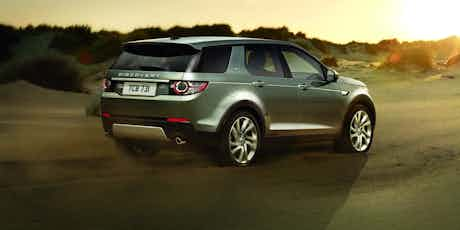Land Rover Discovery Sport – sizes and dimensions guide
April 01, 2015 by carwow staff

Ever since Maurice Wilks first drew a sketch of the first ever Land Rover back in 1947 on a beach in Anglesey, the marque has always been the go-to place for extreme off-road conquering.
They weren’t particularly luxurious – they were, in fact, quite spartan – but they were fantastic at what they were built for. Then along came the Range Rover. This combined all the great off-road capabilities of usual Land Rovers with an added sense of luxury that made them the darlings of the celebrity elite.
Today, we arrive at the Land Rover Discovery Sport: the replacement for the Freelander. Even though it says Land Rover on the bonnet, it’s better thought of as a more practical version of the Range Rover Evoque. So how practical is it and how comfortable would your passengers be? Here’s a guide to help you decide.

Exterior dimensions
Land Rover has done wonders with this new Discovery Sport. It’s actually not that much longer or wider than an ordinary Volkswagen Golf, but it has a total of seven seats. The last row of seating is better suited to children rather than adults but nevertheless, any individual would be able to fit back there for short journeys.
With its compact dimensions and lofty driving position, it’s not that intimidating to drive either, which makes it a lot easier to park and manoeuvre about in tight spaces.
| Length | 4,599mm |
| Width (including mirrors) | 2,173mm |
| Height | 1,741mm |
| Wheelbase | 2,741mm |

Interior dimensions
The interior is very clever on the Discovery Sport. The second row of seats can slide backwards and forwards by up to 16cm and they fold away in a 40:20:40 layout. With the second row of seats slid all the way back, the legroom available becomes as capacious as that in a normal Range Rover.
Space in the third row of seats isn’t great but legroom can be improved by sliding the second row of seats forward. However, head- and legroom in the second and front rows is excellent. The amount of headroom offered for front seat occupants is greater than that in the Range Rover Sport.
| Front headroom with panoramic roof | 1,021mm |
| Rear headroom | 984mm |

Luggage capacity
With the third row folded flat, the boot space available is 981 litres (measured up to the roofline, not to the load cover) and 1,698-litres with all of the seats folded. With the third row of seats in place, there’s a little bit of boot space available but only really for small items.
When all the seats are folded, it creates a flat load bay and there’s no apparent boot lip meaning getting stuff into and out of the car is very easy. There’s also a powered tailgate.
| Boot space (third row folded) | 981 litres |
| Boot space (seconds and third rows folded) | 1,698 litres |

Off-road capabilities and towing
Discovery Sport buyers will probably not be taking it far off-road – leafy back roads would probably be its biggest challenge. Even so, with Land Rover in its name, it has a reputation to fulfil and it doesn’t disappoint. The Discovery Sport gets the same Terrain Response System as found in the bigger and more expensive Range Rover, which means it can tackle any terrain within reason that takes your fancy. It definitely makes it more capable than its nearest rivals for going off-road, that’s for sure.
The maximum the Discovery Sport can tow is 2,200kg with the automatic gearbox fitted. It’s 2000kg for the manual car. A detachable tow bar will cost £675.
| Approach angle | 25° |
| Departure angle | 31° |
| Wading depth | 600mm |
| Max towing weight (auto) | 2,200kg |
| Max towing weight (manual) | 2,000kg |

Fuel tank capacity and range
The Discovery Sport currently only comes with one engine: a 2.2-litre SD4 diesel and the size of its fuel tank is 65-litres. With the automatic gearbox fitted, the maximum theoretical range that can be achieved is just shy of 641 miles. The manual version is a little more economical, achieving a maximum theoretical range of 662 miles.

Weight
With the manual gearbox, the Discovery Sport weighs from 1,854kg. With the automatic gearbox, the car weighs from 1,863kg. Compared to the Evoque, the Discovery sports weighs approximately a quarter of a tonne more and against the BMW X3 it’s 100kg more. However, it does weigh approximately 150kg less than the Hyundai Santa Fe.

Turning circle
The Discovery Sport’s turning circle is 11.6 metres. This is 0.3 metres wider than the Range Rover Evoque and 0.7 metres more than the Hyundai Santa Fe. However, it is smaller than the 11.9 metres achieved by the BMW X3.
A pleasant Discovery
Take a look at our full aggregated review of the Land Rover Discovery Sport then pick which colour you’d like it in using our colours guide. Head over to our car configurator to spec up your perfect Discovery Sport or check out our deals page to see our latest discounts.















